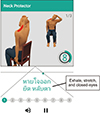1. Sarwar M, Soomro TR. Impact of smartphone's on society. Eur J Sci Res. 2013; 98(2):216–226.
5. Berolo S, Wells RP, Amick BC 3rd. Musculoskeletal symptoms among mobile hand-held device users and their relationship to device use: a preliminary study in a Canadian university population. Appl Ergon. 2011; 42(2):371–378.


6. Namwongsa S, Puntumetakul R, Swangnetr M. Prevalence of musculoskeletal disorders of smartphone users in Khon Kaen University students, Thailand. In : Proceedings of the 2nd Thailand National Ergonomics Conference; 2017 Dec 20-22; Bangkok, Thailand.
7. Lee S, Kang H, Shin G. Head flexion angle while using a smartphone. Ergonomics. 2015; 58(2):220–226.


8. Gold JE, Driban JB, Thomas N, Chakravarty T, Channell V, Komaroff E. Postures, typing strategies, and gender differences in mobile device usage: an observational study. Appl Ergon. 2012; 43(2):408–412.


10. Szeto GP, Straker LM, O'Sullivan PB. Neck-shoulder muscle activity in general and task-specific resting postures of symptomatic computer users with chronic neck pain. Man Ther. 2009; 14(3):338–345.


11. Bonney RA, Corlett EN. Head posture and loading of the cervical spine. Appl Ergon. 2002; 33(5):415–417.


13. Hansraj KK. Assessment of stresses in the cervical spine caused by posture and position of the head. Surg Technol Int. 2014; 25:277–279.

14. Kong YS, Kim YM, Shim JM. The effect of modified cervical exercise on smartphone users with forward head posture. J Phys Ther Sci. 2017; 29(2):328–331.

15. Litman L, Rosen Z, Spierer D, Weinberger-Litman S, Goldschein A, Robinson J. Mobile exercise apps and increased leisure time exercise activity: a moderated mediation analysis of the role of self-efficacy and barriers. J Med Internet Res. 2015; 17(8):e195.

16. Christiansen S, Gupta A. Can mobile technology improve treatment of chronic pain? Pain Med. 2014; 15(8):1434–1435.


17. Lauche R, Stumpe C, Fehr J, Cramer H, Cheng YW, Wayne PM, et al. The effects of Tai Chi and neck exercises in the treatment of chronic nonspecific neck pain: a randomized controlled trial. J Pain. 2016; 17(9):1013–1027.


19. Dou K, Yu P, Deng N, Liu F, Guan Y, Li Z, et al. Patients' acceptance of smartphone health technology for chronic disease management: a theoretical model and empirical test. JMIR Mhealth Uhealth. 2017; 5(12):e177.

20. Wongwilairat K, Buranruk O, Eungpinichpong W, Puntumetakul R, Kantharadussadee-Triamchaisri S. Muscle stretching with deep and slow breathing patterns: a pilot study for therapeutic development. J Complement Integr Med. 2018; 16(2):20170167.

22. Bijur PE, Silver W, Gallagher EJ. Reliability of the visual analog scale for measurement of acute pain. Acad Emerg Med. 2001; 8(12):1153–1157.


23. Kinser AM, Sands WA, Stone MH. Reliability and validity of a pressure algometer. J Strength Cond Res. 2009; 23(1):312–314.


24. Fletcher JP, Bandy WD. Intrarater reliability of CROM measurement of cervical spine active range of motion in persons with and without neck pain. J Orthop Sports Phys Ther. 2008; 38(10):640–645.


25. Brooke J. SUS: a quick and dirty usability scale. Usability Eval Ind. 1996; 189(194):4–7.
26. Lee M, Lee SH, Kim T, Yoo HJ, Kim SH, Suh DW, et al. Feasibility of a smartphone-based exercise program for office workers with neck pain: an individualized approach using a self-classification algorithm. Arch Phys Med Rehabil. 2017; 98(1):80–87.


27. Busch V, Magerl W, Kern U, Haas J, Hajak G, Eichhammer P. The effect of deep and slow breathing on pain perception, autonomic activity, and mood processing: an experimental study. Pain Med. 2012; 13(2):215–228.


28. Berry RR, Lai B. The emerging role of technology in cognitive–behavioral therapy for anxious youth: a review. J Ration Emot Cogn Behav Ther. 2014; 32(1):57–66.

29. Palermo TM, Valenzuela D, Stork PP. A randomized trial of electronic versus paper pain diaries in children: impact on compliance, accuracy, and acceptability. Pain. 2004; 107(3):213–219.


30. Jamison RN, Raymond SA, Levine JG, Slawsby EA, Nedeljkovic SS, Katz NP. Electronic diaries for monitoring chronic pain: 1-year validation study. Pain. 2001; 91(3):277–285.









 PDF
PDF ePub
ePub Citation
Citation Print
Print










 XML Download
XML Download